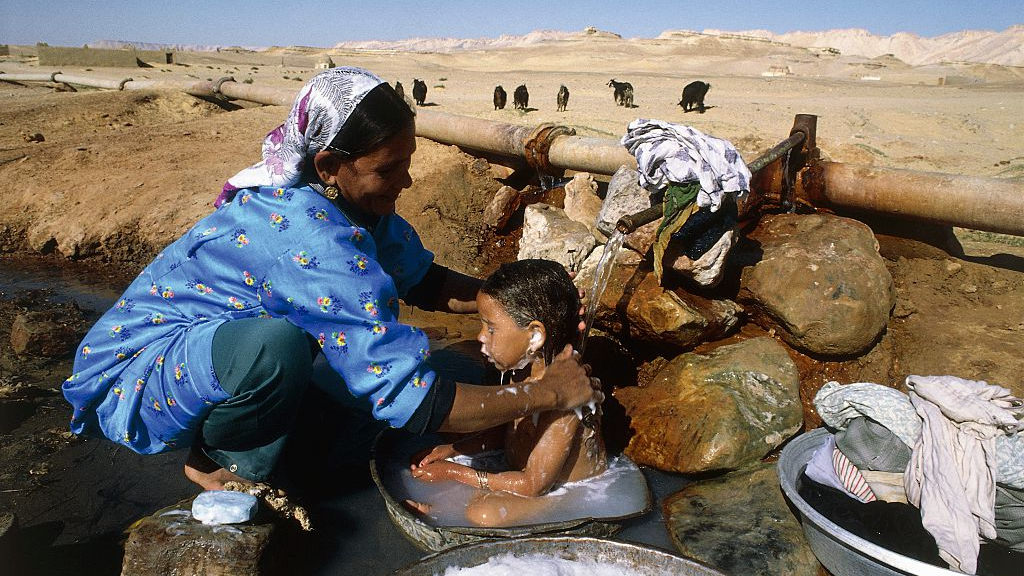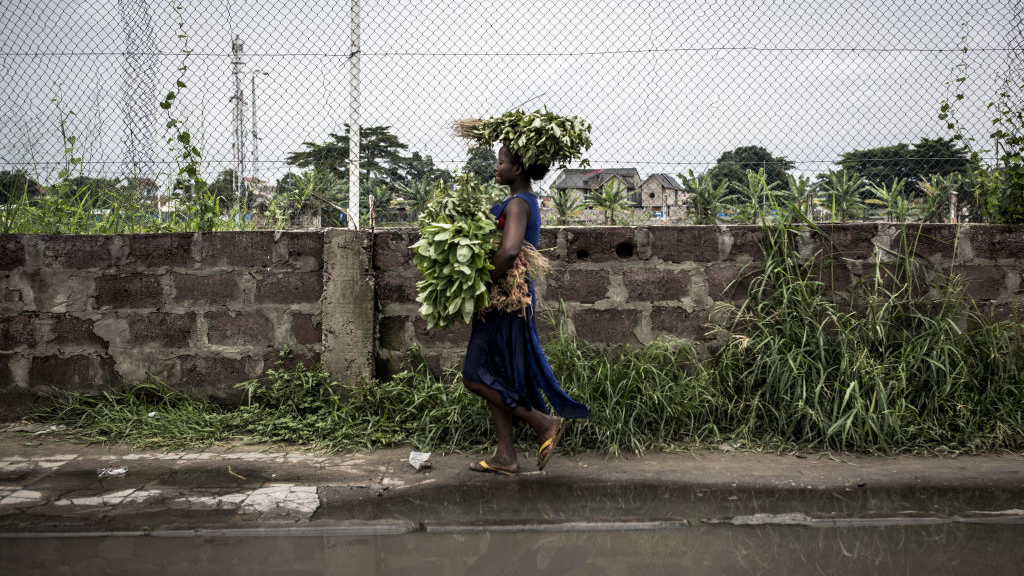
A woman washing a baby in an aqueduct fountain, Kharga oasis, Western Sahara, Egypt, March 18, 2016. /Getty
A woman washing a baby in an aqueduct fountain, Kharga oasis, Western Sahara, Egypt, March 18, 2016. /Getty
Editor's note: Alexander Ayertey Odonkor is an economic consultant, chartered financial analyst and chartered economist with a focus on the economic landscape of countries in Asia and Africa. The article reflects the author's opinions, and not necessarily the views of CGTN.
Alleviating all forms of poverty is one of the United Nations Sustainable Development Goals (UN SDGs). Through coordinated efforts with member countries, the United Nations intends to end all forms of poverty by 2030. Although the goal to eradicate global poverty has been a daunting task, mankind has made remarkable progress in the fight against poverty. The proportion of the global population living in extreme poverty has declined continuously in the last two centuries.
Data from the World Bank suggest that in the last decade, global poverty has reduced significantly. Global extreme poverty rate declined from 10.1 percent in 2015 to 9.2 percent in 2017; this represents 689 million people living on less than $1.90 a day, a decline from almost two billion in 1990. A detailed account of the poverty lines in 2017, indicate that the share of the global population that lived on less than $5.50 and $3.20 a day was 43.6 percent and 24.1 percent, respectively.
Even though some of the extreme poor population can be found in urban areas, the largest share of the extreme poor live in rural areas. For instance in 2018, four out of five people below the international poverty line resided in rural areas, with the majority of the extreme poor being women and children. Overall, more than 40 percent of the global poor can be found in countries plagued with conflict, fragility and violence – with only 10 percent of the world's population domiciled in such countries, the population of the extreme poor in these countries is projected to increase to 67 percent in the next decade.
In spite of the worsening poverty levels in some regions, the progress for eradicating global poverty is encouraging. Significant growth in the global economy and the rising wealth of many developing countries is the key driver of this remarkable progress. As a result of these key drivers, the share of the global poor continues to decline as the years go by.
In 2013, about 11.2 percent of the world's population lived in extreme poverty, a drop from 42.5 percent in 1981. Between 1990 and 2015, the global poverty rate has reduced by an average of 1 percentage point per year. This growth was partly influenced by China's role in poverty alleviation. According to the World Bank, after China's economic reforms in 1978 the country has lifted more than 850 million people out of poverty, the largest in human history. China's efforts in eliminating poverty have been instrumental in reducing poverty, particularly in East Asia and Pacific, where the average poverty rate for countries in the region was 3 percent in 2015, down from 62 percent in 1990.
Despite the fact that the global poverty rate has dropped significantly in recent years, some regions are experiencing a slow reduction in the population of the poor. In South Asia and sub-Saharan Africa, where 80 percent of the global population living on less than $1.90 a day are residing, progress in reducing poverty among countries in these two regions has been sluggish. An in-depth analysis of the performance of the two regions in lifting people out of poverty shows that countries in South Asia are doing quite better than countries in sub-Saharan Africa. In 1990, about half a billion people were living in poverty in South Asia. Through the implementation of effective poverty alleviation program that were aided by favorable economic conditions, the population of the poor in South Asia reduced to 216 million people in 2015.

A woman carries freshly picked vegetables on her head as she walks down the street in Kinshasa, Democratic Republic of the Congo, January 11, 2019. /Getty
A woman carries freshly picked vegetables on her head as she walks down the street in Kinshasa, Democratic Republic of the Congo, January 11, 2019. /Getty
However this impressive progress against poverty in South Asia is in sharp contrast with the slow pace of poverty alleviation in sub-Saharan Africa. As a result of frequent conflicts, weak institutions and growth that does not mollify poverty, sub-Saharan Africa now accounts for the largest share of the global poor. Unlike most regions where the size of the population of the poor continues to shrink, in sub-Saharan Africa the share of the poor is soaring. For instance, the population of the extreme poor in sub-Saharan Africa increased from 278 million in 1990 to 413 million in 2015.
While the average poverty rate for other regions was below 13 percent, sub-Saharan Africa recorded a poverty rate of 41 percent in 2015. Out of the world's 28 poorest countries, sub-Saharan Africa is home to 27 of these poor countries whose poverty rates exceed 30 percent; this deplorable condition is gradually making poverty an African problem.
With high incidence of poverty in the region, it is quite surprising to note that about 50 percent of poor people in sub-Saharan Africa are in just five countries: the Democratic Republic of Congo, Ethiopia, Nigeria, Tanzania, and Madagascar. The reason why countries in sub-Saharan Africa are struggling to eliminate poverty is partly as a result of the region's high dependence on the extractive industry which barely improves the consumption and income level of the poor.
Although the agricultural sector is more effective than any other sector in eradicating poverty, the sector has not been fully developed to improve the income and the consumption level of poor households. This condition is almost the same in South Asia where the agricultural sector has the potential to lift many poor people out of poverty but the poorly developed agricultural sector is impeding progress in the fight against poverty.
With agriculture serving as the major source of livelihood and the main driver of growth in sub-Saharan Africa and South Asia, providing adequate resources for the efficient operation of the agriculture value chains and making farming a lucrative venture will be a key driver of growth that could lift many poor households out of poverty in these two regions.
(If you want to contribute and have specific expertise, please contact us at opinions@cgtn.com.)

